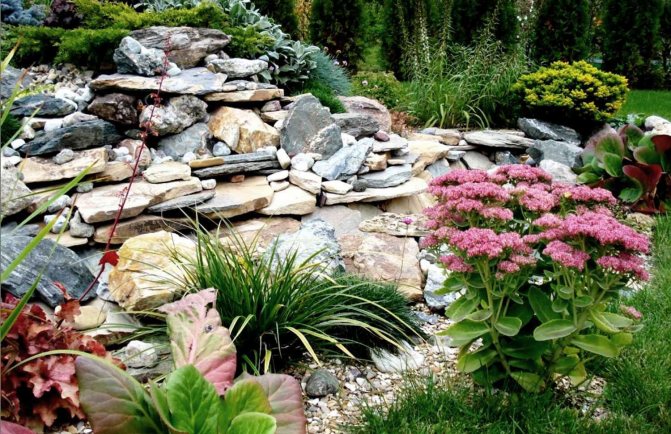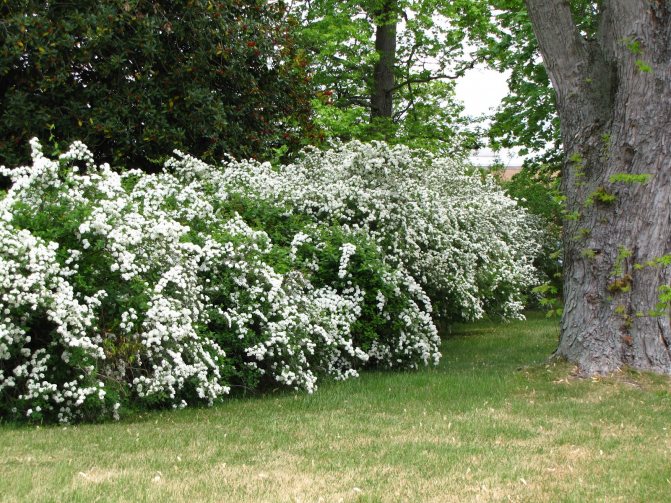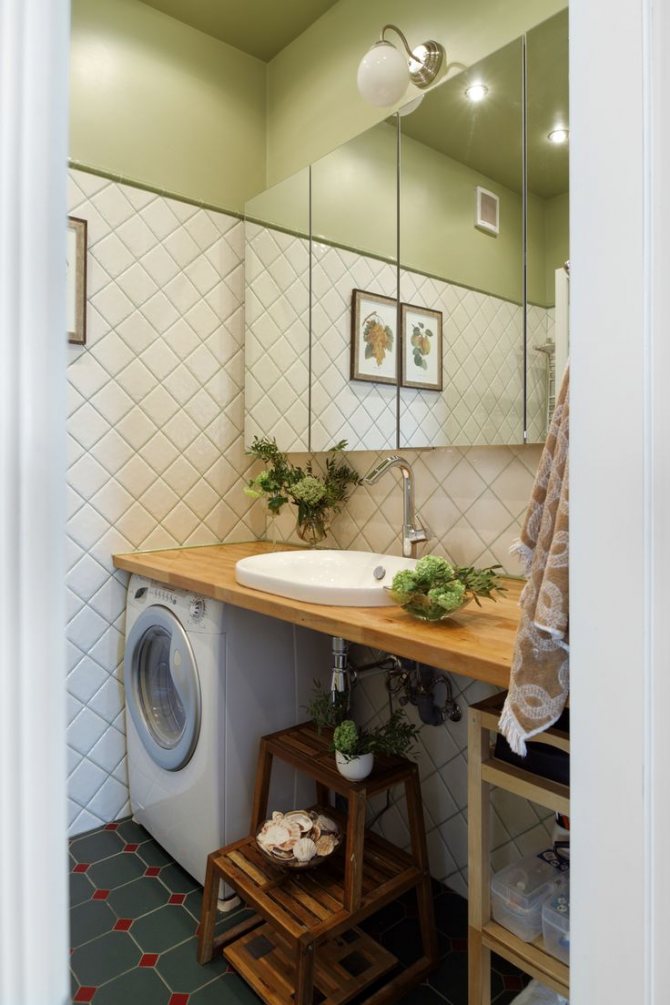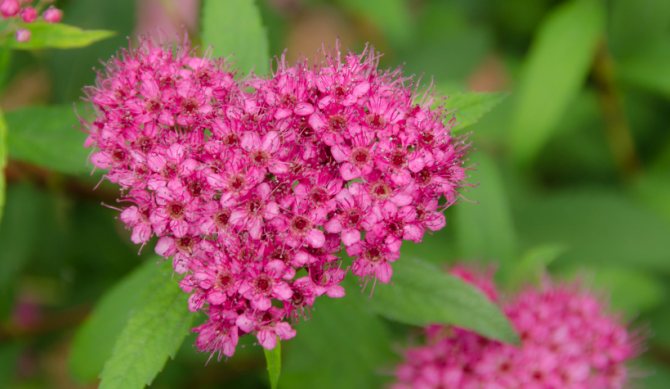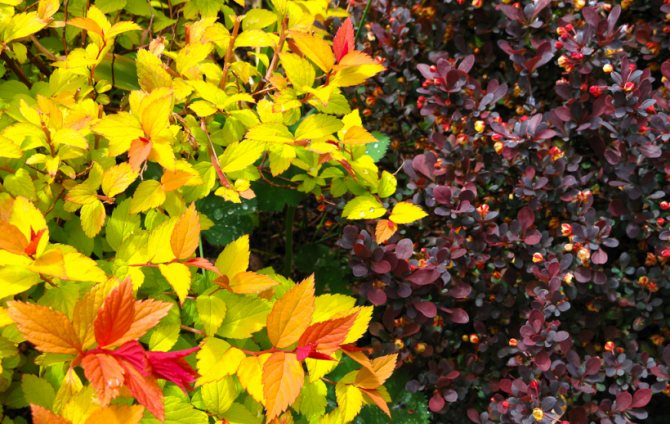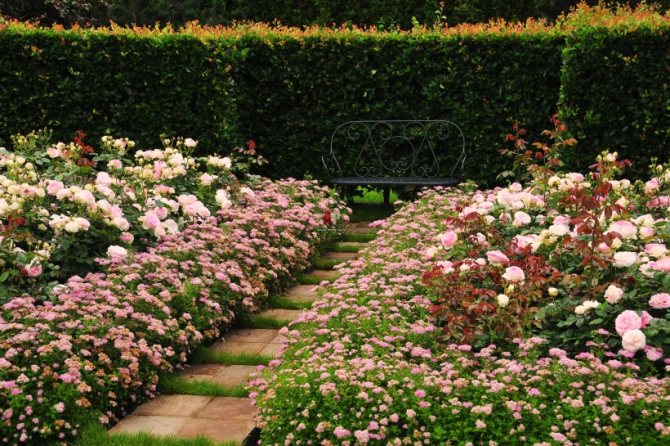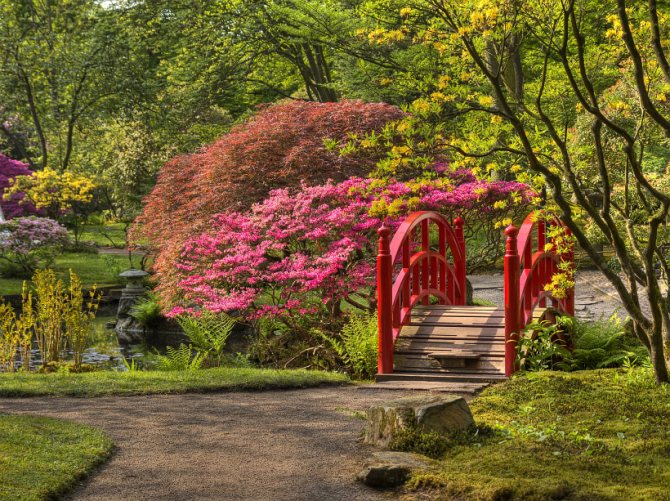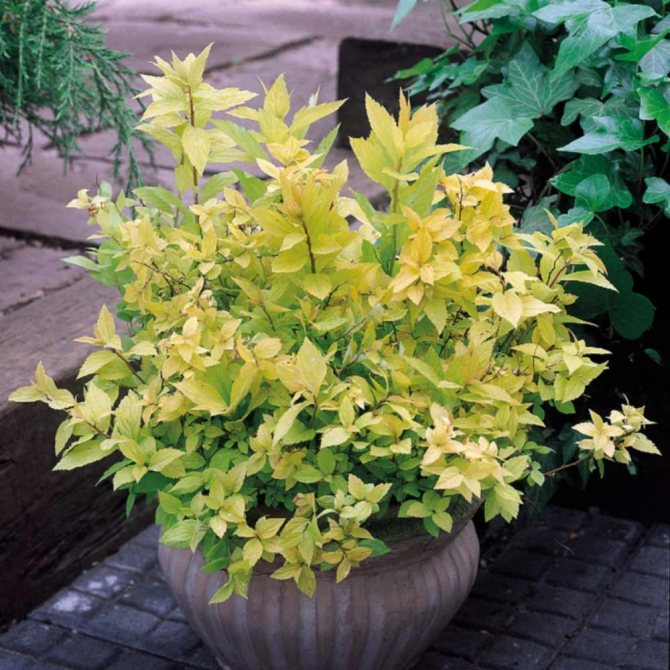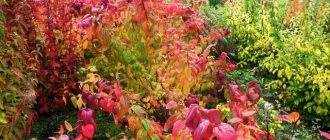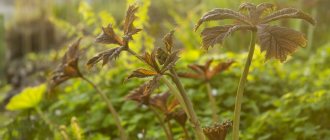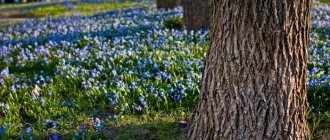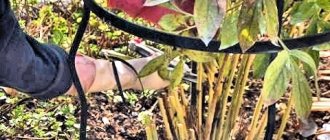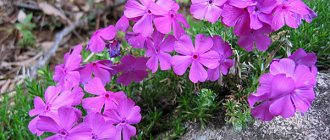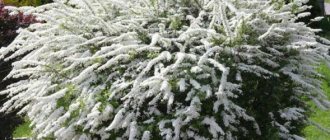This unpretentious, easily propagating and luxuriously flowering plant is able to decorate any garden. At the same time, many are attracted by the fact that performing such work as planting and leaving will not cause any difficulties even for novice gardeners.

Appearance
There are quite a few varieties and types of spirea. All of them differ among themselves not only in preferences in care, but also in decorative characteristics. For example, in landscape design, you can find varieties that grow in height by only 20 centimeters. And some varieties even exceed human growth, reaching 2 meters in height.
However, all plants have something in common - a fibrous root system, which is located quite close to the surface. In addition, spirea is so popular due to its luxurious appearance, which is given to it by numerous flowers collected in inflorescences. As a rule, they are placed on separate branches, however, the density of the arrangement creates the appearance of a chic natural ensemble that pleases the eye of any connoisseur of beauty.
The color of flowers in most cases depends on the flowering period of a particular variety. For example, summer varieties usually have deep red or pale pink hues. In the spring, you can see how the white spirea blooms. Well, the autumn varieties delight the eye with purple hues. Thanks to such a variety of color palettes, landscape designers and flower growers manage to create truly unusual and beautiful compositions.
Also, the season affects the appearance of inflorescences, which can be presented in the form of complex panicles, umbrellas, brushes or shields. The petals of this culture grow in succession, so the shades of even white flowers can vary from pale yellow to snow-white. As for the branches, depending on the flowering season, they can be spreading, lying, tending upward or straight.
Reproduction
Depending on the species, the spirea is propagated in different ways:
- cuttings - green, semi-lignified, lignified;
- horizontal layering;
- divisions of the bush;
- seeds.
Some species (Wangutta) do not produce seeds and reproduce only by shoots.
Seating the shoots
The easiest way to propagate spirea is to transplant shoots that appear next to adult bushes. Dig up the soil and cut off a young shoot near the root. A young plant is immediately planted in the ground or, if its root system is not sufficiently developed, in a pot.


Green cuttings
Another way of propagation is by cuttings. Stems are green or semi-lignified, but still flexible, cut in summer. The cuttings are dipped in a rooting agent and planted in peat mixed with vermiculite. Caring for cuttings requires constant monitoring of the correct soil and air moisture. Usually, spirea cuttings have no rooting problems.
A pot of cuttings cannot be kept in full sun. Cuttings from semi-lignified shoots are covered with a film. The film is spread on a wire or sticks buried in the ground so that it does not touch the cuttings.
Lignified shoots are cut in the fall when the plant sheds its leaves. Lignified cuttings are not as susceptible to overdrying as semi-lignified ones.It is necessary to provide them with a low temperature in winter, in the spring they are planted in a school. Young spireas are planted in a permanent place after 1-2 years, when a strong root system develops.
Lignified cuttings
Caring for woody cuttings requires less effort. In an adult plant, lignified shoots are cut and cut into cuttings.
Attention! To avoid planting a plant incompatible with the polarity (do not confuse the top and bottom), the lower part is cut at an oblique angle, and the upper one - at a right angle.
Picture:
1) properly cut cuttings, 2) depth of placement in the ground, 3) rooted seedlings.


The tops of the cuttings are positioned flush with the substrate surface. The optimum temperature for root development is 22-26 ° C. Young plants are planted in separate pots when their roots are 2.5 cm long - usually after 6 months. Before planting in a permanent place, the seedlings are hardened in a greenhouse for 3 weeks.
Description and photos of varieties and types of spirea
As mentioned earlier, spirea has a fairly large number of varieties (about 100). It should be noted right away that not all of them are equally well suited for growing in Russia. Therefore, further in the article you will find only 3 of the most popular varieties that are actively used in landscape design. In the following sections, a lot of photos will also be presented that will allow you to enjoy the beauty of the spirea.


Gray spirea is the most common specimen in our country. This shrub blooms with white and lush flowers in early summer. Sometimes they bloom so much that brown branches are almost invisible. Well, the variety got its name because of the unusual color of the leaves, which has a green-gray tint. The maximum height of the bush is 185 centimeters.
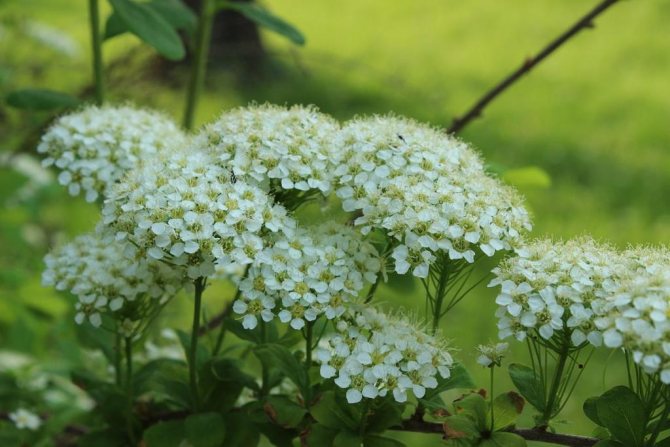

The middle spirea is most often found in the forests of Eastern Siberia or the Far Eastern region. Despite its name, the height of the culture is one of the highest - about 2.2 meters. The flowering period is in late spring. The flowers are white with a yellow core. A distinctive feature of the variety is its high resistance to prolonged frosts and droughts. This variety can be safely considered one of the most unpretentious.


White spirea is also quite common in Russia. It is known that this variety was grown on the territory of our country back in the distant 18th century. However, due to the fact that the variety is quite demanding in care, today it is no longer so popular. But all the efforts of the gardener will be more than offset by the beauty of flowering. Snow-white clusters on green leaves - what could be more beautiful than this sight? the height of the culture is 170 centimeters.
Shrub description
Spiraea is a genus belonging to the Rosaceae family, which includes several dozen species. Many species are valuable ornamental shrubs, usually sold in nurseries and retail outlets. The shrub is often referred to as the "white bride" for its magnificent, exuberant bloom of many small white flowers. Some species have pink flowers.


In the wild, we can admire Spiraea salicifolia and Spiraea media.


The most popular species of the genus Spiraea
| Spirea type | Latin name |
| Willow | Spiraea salicifolia |
| Japanese | Spiraea japonica |
| Gray | Spiraea x cinerea |
| Cantonese | Spiraea cantoniensis |
| Billard | Spiraea x billardii |
| Nippon | Spiraea nipponica |
| Berezolistnaya | Spiraea betulifolia |
| Jagged | Spiraea x arguta |
| Wangutta | Spiraea x vanhouttei |
| Menzies | Spiraea menziesii |
| Three-bladed | Spiraea trilobata |
| Vicha | Spiraea veitchii |
| Douglas | Spiraea douglasie |
| Short-branched | Spiraea x brachybotrys |
| White-flowered | Spiraea albiflora |
| Animal-leaved | Spiraea hypericifolia |
| Dubravkolistnaya | Spiraea chmaedryfolia |
| Thunberg | Spiraea thunbergii |
| Creeping | Spiraea decumbens |
| Slate | Spiraea prunifolia |
Planting spirea in open soil
Now you know about the varieties and types of spirea found in Russia. This information should help you decide what kind of shrub to plant in your yard.However, if you decide to resort to this procedure, then you should know that despite the unpretentiousness of the spirea, it should still be planted according to certain rules. Otherwise, the root system of the plant will be severely damaged.
It is important to pay special attention to the distance between adjacent bushes, because otherwise the branches of the spirea will interfere with each other to grow normally and receive the optimal amount of sunlight. In addition, with too abundant planting, excess moisture simply will not evaporate from the soil, which is fraught with the development of fungal infections. The optimal distance between adjacent seedlings for most varieties is from 0.7 to 1 meter.
Biological features
Japanese spirea, resistant to many unfavorable conditions, is successfully grown in almost all regions of our country, from the southern borders to the Arctic. It can grow even without the presence of fertile soil, top dressing, watering and shelter for the winter.


Japanese spirea is watered, as a rule, only the first year of its life. It is also optional to trim it. The height of the plant bushes depends on the variety and varies in the range of 20-150 cm. The crown of this type of spirea is hemispherical without "bare legs", sometimes thick, and sometimes a little "ruffled".
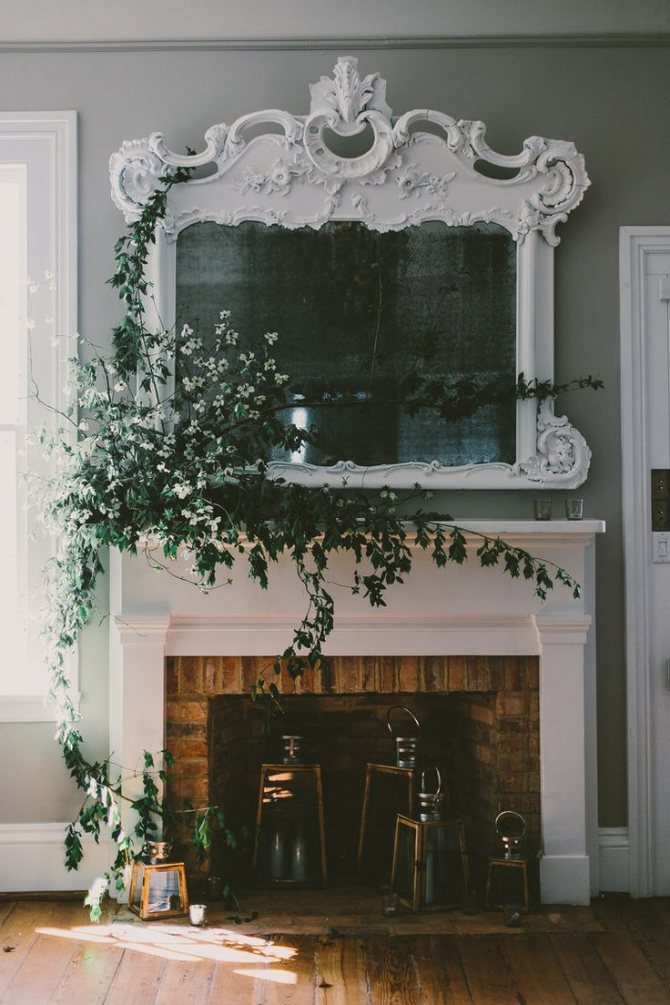

How to buy seedlings correctly?
In most cases, flower growers who decide to start growing one or another variety of spirea do not purchase seeds or cuttings from their colleagues, but ready-made plots that must be immediately planted in the soil. However, it is recommended that you only do this with a seller you really trust. Otherwise, there is a high probability of purchasing a variety that does not correspond to the description, as a result of which the composition will be disturbed.
When buying planting material, you need to pay special attention to the rhizomes of plants, because the speed of plant survival in new conditions directly depends on their health. It is best to choose a specimen that has at least 3 strong rods, as well as a healthy lobe (it should not have traces of infection or mechanical damage. Also, do not purchase shoots on which leaves have not fallen (too young material).
After purchasing seedlings, it is necessary to shorten overgrown roots, as they can provoke damage during planting. In some cases, the root system may be too dry. Then it should be soaked in water for several hours. As for the time for planting, this procedure can be carried out throughout the growing season (from early April to late October), but it is best to do this in the spring.
Planting, growing and care
Spireas are easy to grow and require little maintenance. Many species are quite undemanding to soils, frost-resistant, therefore they are available for planting in the Urals, Siberia, the Moscow region, in most regions of Russia.
The spirea shrub does not require preparation for winter; care in the fall includes the cleaning of fallen leaves. Most of the species are resistant to periodic droughts, frosts, and air pollution.
When to plant?
Spirea can be planted in the ground in spring and autumn - from April to October, when there is no frost. When planting in spring, especially in the initial period, in the absence of precipitation, the lack of water must be replenished. Well-rooted shrubs cope with drought.
Choosing a landing site
Spirea prefers sunny positions in which the shrub blooms profusely. Plants also grow in the shade, but flower less well. Spirea has no special requirements for the substrate. The shrub can handle most soils.
For some types, the requirements are different:
- Japanese spireas have increased requirements for soil and moisture. Plants prefer fertile, sufficiently moist soil, they tolerate frost.
- Sharp-toothed spirea can sometimes freeze.


Soil preparation, planting
- To improve the quality of the soil, to provide the plant with minerals in a safe amount, it is worth adding processed, rotted compost to the soil intended for planting shrubs.
- Before planting, thoroughly prepare the soil, removing weeds.
- A seedling hole is dug up to a depth of 2 times the width of the seedling roots. The depth of the hole should be equal to the depth of the container from which the spirea seedling is transplanted.
- The bottom of the pit is covered with garden soil mixed with manure or decomposed compost. The shrub does not like highly compacted soil in which it is difficult for roots to break through.
- If the spirea is planted on heavy loamy soil, drainage must be provided to the roots. Gravel mixed with coarse sand is laid at the bottom of the pit. In the case of flooded soil, it is also worth placing drainage on the side walls of the pit.
- The soil in which the shrub is planted must be thoroughly moistened. Water the seedling before removing it from the container, because overdried roots can prevent the plant from taking over in a new place.
- Tangled roots should be loosened before planting to help them grow.
- The seedling is placed in a pit, filled with garden soil mixed with rotted compost, trampled on the ground around the spirea and watered again.


An adult spirea successfully tolerates a transplant. The shrub must be dug out with a large lump of soil so that the roots are not severely damaged.
Mulching
Immediately after planting and watering a young plant, it is worth mulching the soil around it. This will limit the evaporation of water, which is especially important on sandy soils, and will significantly reduce the number of germinating weeds. The grass growing near the trunk does not harm only mature plants.
Suitable for mulching gravel, you can use organic material - crushed bark, which provides the plant with nutrients.
Fertilizer
Spireas can be fed with mineral fertilizers in spring and summer, but no later than the end of June. The supply of nitrogen delays the lignification of the shoots, which negatively affects the wintering of plants. Young bushes in the first year after planting should not receive a full dose of fertilizer, especially if fertilizer is applied during planting.
Watering
Spirea is drought tolerant. It is better to water with plenty of water at a time. So the water will penetrate through the shriveled soil deeper to the roots. Saplings require much more attention. Young plants are watered regularly, preferably by drip, because sprinkling increases the risk of fungal diseases.
How to trim spirea?
Shrub pruning is carried out in accordance with the requirements of a particular type:
- Species blooming on shoots of the current year (for example, Japanese) should be pruned in early spring, before the beginning of the growing season. Pruning is done with a "hedgehog" just above the ground. Strong pruning provides the shrub with a decorative crown and abundant flowering. Similarly, cut off low, little bushy, ground cover shrubs, also blooming on annual shoots.
- Shrubs blooming on last year's shoots can be trimmed after flowering. For these species, annual pruning is not required. It is performed as needed, removing dried branches. Anti-aging pruning should be done every few decades.


After flowering, you need to remove the faded inflorescences along with some shoots located under them (thinning). The shrub is cut to form a hemisphere.
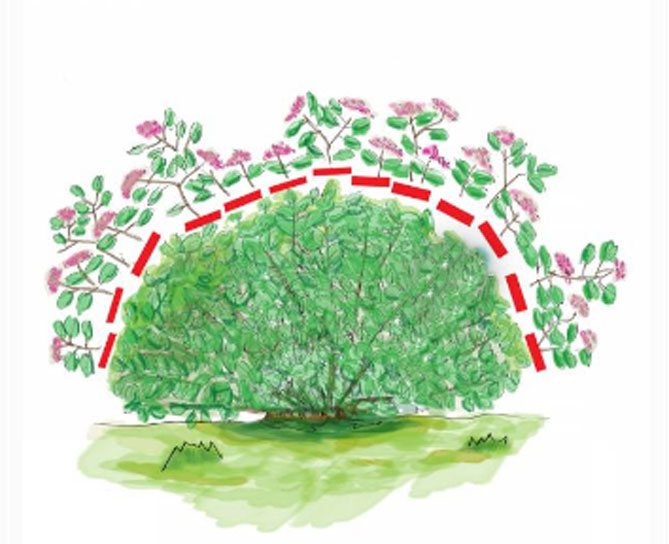

Correct soil preparation
If you decide to plant a spirea shrub in your yard, then first you need to find a suitable site for this. The culture is extremely demanding on sunlight, so it is recommended that you choose a place that is under the sun for most of the day. But in the shade, the spirea will produce very few inflorescences, so it is better to refrain from planting it in the northern part of the yard.But the plant is practically not afraid of wind and cold drafts.
But regarding the soil, the culture does not have any special preferences. The most important thing is that it is fertile. However, if you have the opportunity to prepare a good composition, then give preference to neutral soils, such as sod land. If planting is carried out in loam, then be sure to pour a small amount of peat or sand on the bottom - in such soil the plant will take root much faster.
You can also add fertilizer to each hole before planting. However, do this 2-3 days in advance so that they have time to properly dissolve in the soil. Humus or compost should be preferred. As for mineral dressings, you can use complex formulations for horticultural crops, which contain a large amount of nitrogen and potassium (spirea is neutral to phosphorus). The most important thing is not to overdo it with feeding, so that the plant does not die.
How to make holes correctly? For tall varieties, their depth should be from 70 to 80 centimeters. When it comes to planting a small crop, then the size is reduced by about half. However, in any case, it is highly recommended to set aside an additional 10 centimeters in order to make the drainage layer. For this purpose, broken brick, gravel or pebbles are suitable. Thanks to the drainage layer, moisture will never be trapped in the soil.
Application
Species diversity allows you to use the shrub in a very diverse way.
Spirea is a great plant for creating a hedge.
To create a formed hedge, the following types are suitable:
- sharp-toothed (Spiraea x arguta),
- Wangutta (Spiraea x vanhouttei),
- Menzies (Spiraea menziesii).
For low hedges and curbs, the Japanese species (Spiraea japonica) can be used.
Spirea looks beautiful, growing in the garden alone and in a group. Low types, for example, Japanese, are ideal for a variety of plantings in containers, grown on terraces, balconies. Certain species are used as ground cover plants.
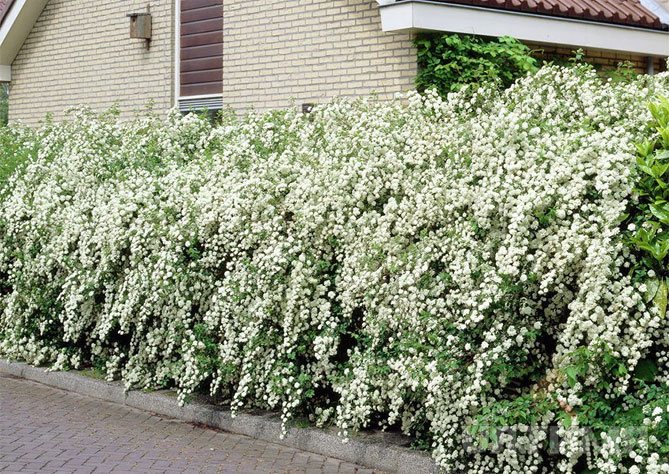

Landing algorithm and tips from professionals
For a novice gardener, planting different types of spirea can seem like a rather difficult task. Therefore, it is necessary to follow a certain algorithm of actions:
- Prepare a hole that is three times the size of the root system.
- Place a drainage layer on the bottom of the hole using broken brick or pebbles.
- Place the bush vertically and distribute the roots evenly.
- Fill the hole with soil until the soil level is leveled.
- Slightly compact the soil with your hands (but not too much, so as not to damage the roots).
- Water the plant with two buckets of rain or standing water.
- Pour a layer of mulch on top, up to 5 centimeters thick (peat, sawdust, needles, scraps, etc.).
Professional flower growers consider September to be the most optimal time of the year for autumn planting, since this month the flowers of most varieties (which are used in landscape design in Russia) have already bloomed, and frosts will not come soon. So the plant will have time to take root before the cold weather.
But in the spring it is usually customary to plant those varieties that bloom late. This should be done until the buds begin to swell, and the plant is still dormant. Professional gardeners recommend choosing a cool day for planting, which does not portend rainfall.
Description of spirea
Semi-deserts, steppe and forest-steppe regions are territories where the beautiful spirea feels comfortable. Its types are diverse and are characterized by frost resistance, decorative effect and duration of flowering. Among the varieties of spirea, there are both dwarf specimens (up to 15 cm high) and tall ones, reaching 2.5 meters.Spirea is a shrub with a lobular root system that goes shallow underground. The branches of a shrub, the color of which in nature is from light brown to dark, erect or creeping, spreading or recumbent. The bark has the property of longitudinal flaking. Spirea leaves are alternate, petiolate, lanceolate or rounded, three- or five-lobed. Small numerous flowers, the color of which varies from pale white to crimson, form inflorescences of various shapes: paniculate, pyramidal, spike-shaped, corymbose. She is such a beautiful and diverse spirea. Its species are characterized by a different position of the inflorescences: in some they are located along the entire length of the shoots, in others - only on the upper part, in others - at the ends of the branches.
How to properly water your crop?
It should be understood that different types and varieties of spirea differ in their individual care preferences. And although the culture is unpretentious, you still need to follow certain rules in order to achieve a beautiful flowering. For example, it is important to follow certain recommendations during watering so that the plant does not experience a lack of moisture, but also does not dry out from root rot.
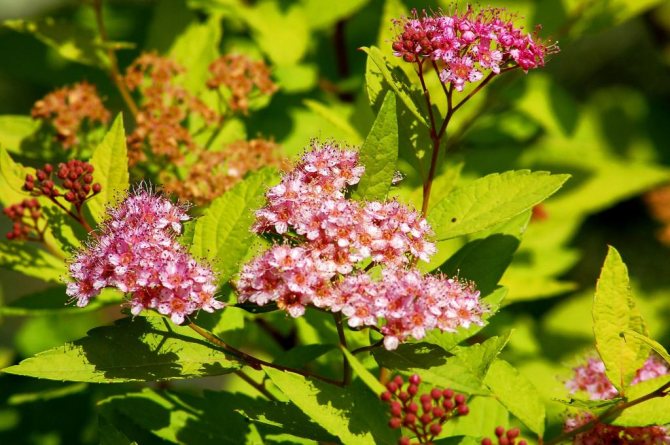

The root structure of the tree is arranged in such a way that it extends several meters deep. In this regard, watering the bush has one very important feature - it should be quite abundant. As a rule, one adult variety will have to use about 15-20 liters of water at a time. Low-growing bushes need 10-15 liters. However, it is by no means necessary to water spirea in any case, since this will provoke stagnation of moisture in the soil.
Also, during watering, it is strongly recommended not to allow the soil to harden, so as not to block the access of oxygen to the root system. Responsible gardeners recommend that you regularly loosen the soil after moisture has been introduced into it, but do it carefully so as not to damage the roots. It is also worth getting rid of weeds in time by uprooting them, as they will take moisture and useful microelements from the soil.
general characteristics
Spirea, easily adapted to the Russian climate, is grown in many regions of the Russian Federation. The genus Spirea includes about 90 varieties of this plant. And thanks to the work of breeders, the emergence of new interesting varieties of it is constantly observed.


The most popular among landscape designers is Japanese spirea, in the scientific world called Spiraea japonica and arrived in Russia from China and Japan. Many gardeners love her very much for a long and luxurious flowering.
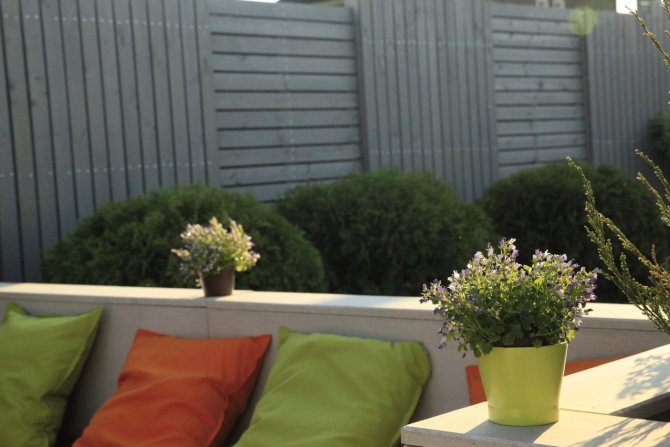

Its elliptical leaves have an interesting feature. In spring, blooming, they become reddish-brownish, with the arrival of summer they turn green, in autumn they again begin to acquire a reddish tint. But today, breeders have already obtained varieties that do not change the color of their foliage from spring to autumn.
Japanese spirea surpasses all representatives of its genus in terms of flowering duration. Beginning in mid-June, pleasantly scented flower hats appear on it, presenting a spectacular sight that can be admired until autumn.
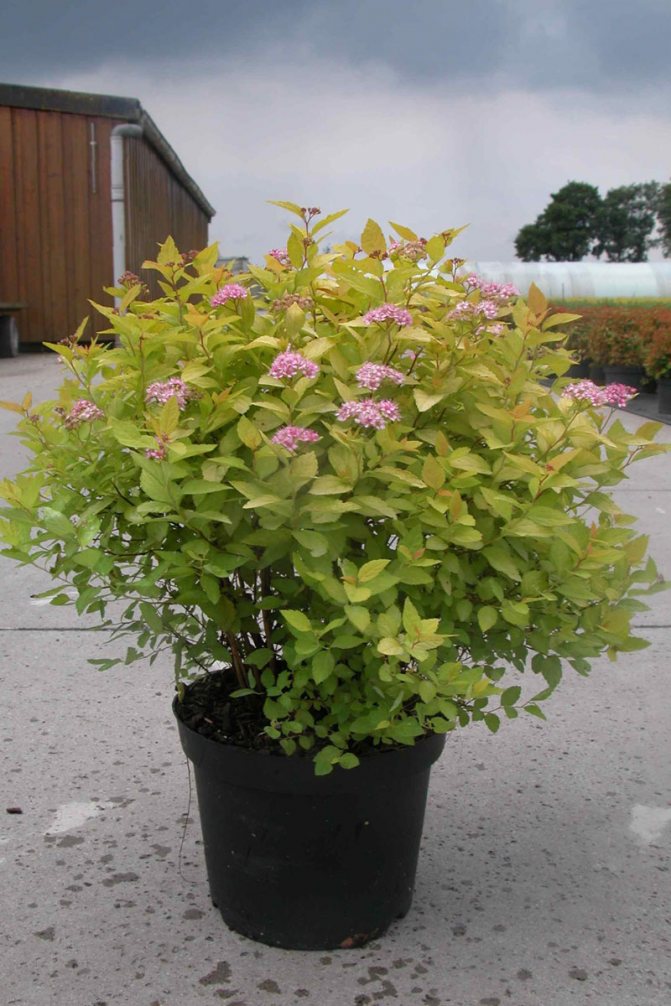

When should you fertilize?
The first feeding of the spirea is done even during the planting of the crop. In the future, the procedure is repeated three times a year: in spring, summer and autumn. Moreover, it is worth noting that at each time of the year it is necessary to use certain compositions:
- Spring. The first feeding is done immediately after the plant leaves its hibernation and begins to dissolve buds with leaves. As a fertilizer, manure or urea diluted in water in a ratio of 1 to 10 is perfect. However, bird droppings should not be used as top dressing, as it can be detrimental to the crop. It is best to give preference to pork, cow or horse manure.
- Summer.At the beginning of the warm season, spiraea should be fed with complex mineral fertilizers, which contain a large amount of potassium. This is especially true for those crops whose flowering period occurs in the hot months. Dilute the drug strictly according to the instructions! In case of an overdose of microelements, the flowers will begin to fall off, and the buds that have not set will simply stop forming.
- Fall. In order to properly prepare the culture for hibernation, it is recommended to use mineral fertilizers based on phosphorus. As a rule, such preparations are applied to the soil in a dry form. It is necessary to sprinkle the granules before the rain so that the soil absorbs them as soon as possible. If precipitation is not expected, then you can use a hoe to bury them yourself in the top layer of the earth.
The basic rule of feeding any ornamental crop is to follow the manufacturer's instructions or the advice of experienced gardeners exactly. Even a small overdose can cause the death of the plant. This is especially true for the introduction of organic and nitrogenous fertilizers, which simply burn out the root system of the plant in an overly concentrated form. If you doubt your actions, then it would be best to refrain from feeding at all.
Plant care
Although Japanese spiraea belongs to unpretentious plants, with proper care, you can achieve its more vigorous growth. In this case, it is necessary to periodically loosen the soil and carry out weeding. Then the spirea will delight you with the bewitching beauty of its exuberant flowering. She tolerates a haircut that turns her into an extraordinary flowering hedge.
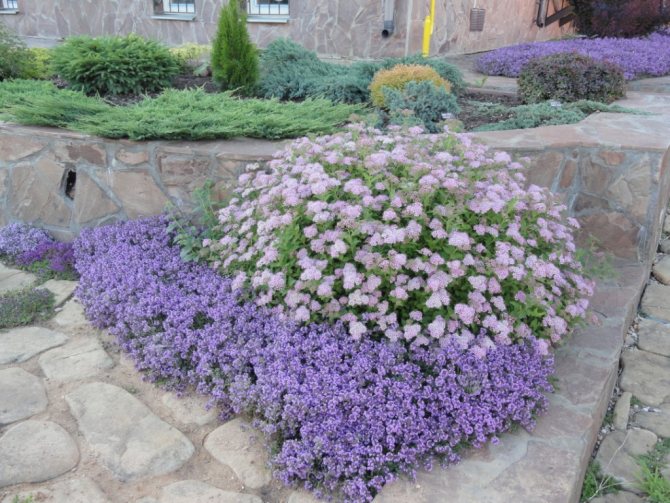

Watering
In the Japanese spirea, the root system is located near the surface of the earth, so the plant does not feel well in drought, and at this time it needs to provide a lot of moisture, pouring two to three buckets of water under its bush every 14 days. After pruning, it is also recommended to water the spirea bush abundantly for several weeks.


Top dressing
It is necessary annually in the soil, in the place where the Japanese spirea is planted, to close up mulch, which should contain peat, as well as compost or crushed bark. It is also recommended to feed the plant immediately after cutting it with mineral fertilizers.


Pruning
Plants are pruned in order, firstly, to give the bush a shape, and, secondly, to remove ugly, dried or aging shoots, which are shortened to the locations of viable large buds.


When rejuvenating Japanese spirea, do not be afraid to remove excess.
With bold, high-quality pruning, you can only increase the number of new shoots. Without such a procedure, the old branches of the bush will tilt it down, and the top will begin to dry out.
Some experienced gardeners advise pruning the bush every four years so that only 30 centimeters of its height from the ground remains.
Preparing the culture for the first wintering
Spirea does not need artificial shelters that could help her survive the cold season. However, if we are talking about a young plant, then it is still recommended to prepare the culture for wintering. It is best to use ordinary mulch for this in the form of peat, humus, spruce branches, dried leaves or sawdust. Just lay the natural insulation near the stem so that it is 10 to 15 centimeters thick.
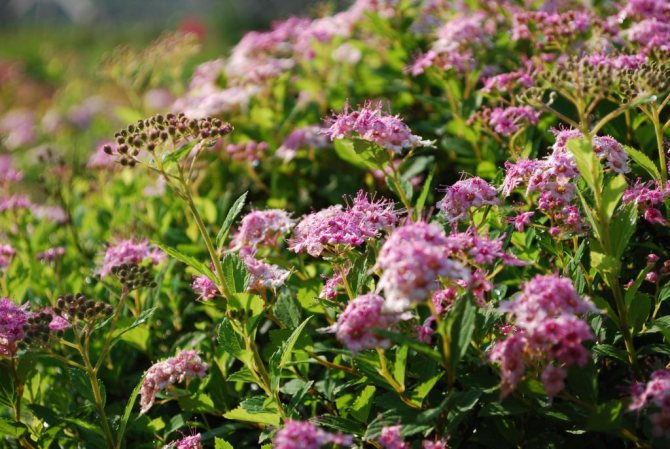

If winter promises to be harsh, then you can try to build a special shelter for a young culture. For example, you can make a special wooden frame in the form of a pyramid, which will only have to be covered with protective material. Or use ordinary metal arcs that are easy to deform. It is recommended to use a breathable material such as burlap or agrofibre as a cover.
The procedure for preparing a plant for wintering is carried out in early December or late November (for cold regions).If it turns out that the plant is already covered, and the outside temperature is above zero, you can remove the frame. However, the mulch should never be touched. The winter sun will not warm the earth well enough, and a layer of peat or sawdust will retain the heat that has remained since autumn. It is recommended to completely remove the frame in early March.
Varieties of Japanese spirea
Spirea Japanese "Golden princesses". Shrub with a spherical crown, oval yellow leaves and corymbose inflorescences, consisting of pink-red flowers. Flowering occurs in June - July.
Spirea Japanese "Little princesses". A short shrub, up to 60 cm. The crown is 1.2 meters in diameter, round. The leaves are oval, dark green. Inflorescences are corymbose, composed of red-pink flowers.
Spirea Japanese "Shirobana". The shrub is low, up to 80 cm with a fairly spreading (up to 1.2 meters in diameter) crown. The leaves are small, dark green, narrow-lanceolate. The snow-white or pink bloom is mesmerizing, in terms of July - August.
Spirea Japanese "Goldflame". It is a low shrub, reaching a height of 80 cm, with small red-pink flowers. Such a spirea is original due to the yellow-orange leaves, which eventually become bright yellow, and in the fall acquire a copper-orange color. Spirea yellow Goldflame is a true decoration of the site, repeatedly changing the shades of foliage during the season.
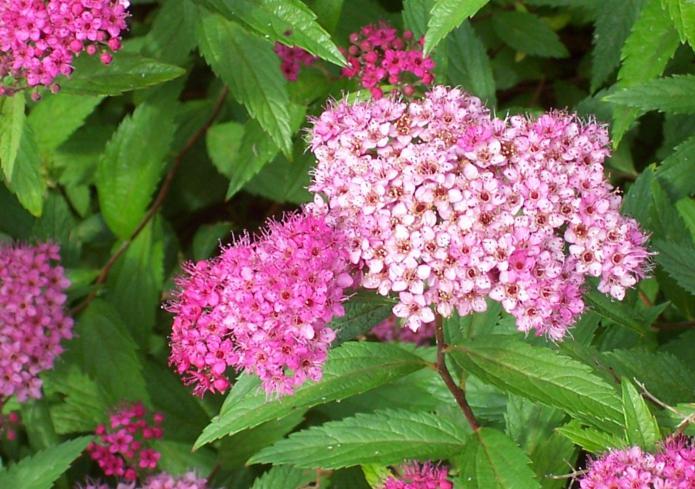

Spirea Japanese "Crispa". Such a shrub stands out for its original openwork; its height is about half a meter, somewhat more wide. The spherical crown with numerous erect shoots is distinguished by pale pink umbrella-type inflorescences. Flowering occurs in July and lasts about 2 months.
How to fight insect pests?
Unfortunately, quite a few ornamental crops are affected by insects, the activity of which negatively affects the life of the plant. Also, one cannot ignore the fact that it will be extremely difficult to process a garden crop with small petals. Even if you purchase a powerful insecticidal agent, it is far from a fact that it will kill all parasites the first time.


What insects should be feared when growing spirea:
- Spider mite. Most novice gardeners and gardeners believe that this one will amaze pays attention exclusively to those crops that bear fruit. However, in reality, the spider mite does not really mind eating the juices of even ornamental plants. It will be quite difficult to notice it on the spirea, since the insect is small in size. However, this mite weaves a web that glistens in the sun.
- Aphid. One of the most common pests that can destroy any garden crops. The main problem with aphid control is that the insect multiplies very quickly. If the gardener does not notice its presence on the crop in time, then the parasite can suck out all the vital juices from the young leaves, as a result of which the plant will get sick and will not please you this year with its abundant flowering.
- Scratch. This microscopic parasite has dimensions from 0.3 to 0.4 millimeters, so it will be extremely difficult to notice it with the naked eye. In the course of its life, it can destroy not only the leaves of the plant, but even young shoots. However, it should be noted that he settles, as a rule, only in an environment that is characterized by high humidity.
If you find this or that parasite on an ornamental culture, it is best to immediately treat the plant with a powerful insecticidal agent, for example, Fitoverm. The drug has a biological composition, therefore it is practically non-toxic to humans. Well, in the most advanced cases, when insects have already formed a colony on a bush, you should use "Aktar".However, keep in mind the fact that you will have to process the plant with a respirator on your face.
Diseases and pests
Sometimes the decorative effect of spirea can destroy diseases or pests.
Errors in care, why does not spirea bloom?
Spirea likes sunny positions in which the bushes bloom profusely and fertile, permeable soil. In a very wet substrate, the spirea will grow poorly. Do not forget about correct pruning, which ensures a dense crown and abundant flowering.
Sometimes the spirea does not bloom, because it is heavily cut off. Spring blooming species (gray) are pruned after flowering, summer blooming (Japanese) species are pruned in early spring.
Weakened by poor care, spirea is more susceptible to disease or pests. Leaf spots, wilting shoots, and lack of flowers are common symptoms caused by infection.
Fungal diseases
Usually spireas are resistant to fungal diseases. But frequent rainfall, high humidity, or pruning wounds can contribute to infection. Prevention and a quick response are essential in the case of fungal diseases.
Control measures:
- fungicidal plant protection products should be applied twice with an interval of 10-14 days;
- Infected shoots should be removed by pruning where healthy tissue is present.
Leaf spot
The reason why the shrub does not bloom, the foliage turns brown, withers, may be the spotted leaves of the spirea. In summer, small round spots appear on the youngest leaves, sometimes with a red border. Leaves with a lot of spots completely turn brown, wither, die off. To prevent the disease, prophylactically it is necessary to rake and remove fallen leaves in the fall. If symptoms of the disease are noticed, the shrub should be sprayed twice with Topsin (Topsin M 500 SC).
Powdery mildew
Symptoms of the disease - white uneven spots and white powdery coating appear on the leaves of the spirea. At first, the spots are small, over time they increase until they cover the entire surface of the leaf blade. The disease often affects flower buds. Infection can lead to deformation of whole bushes, inhibition of growth, premature fall of leaves. Controlling, preventing and treating powdery mildew is identical to controlling leaf blight.
Mites
Another reason why the spirea does not bloom, withers, is acarinosis, the defeat of the four-legged tick Phyllocoptes spiraeae. More often the pest infects Japanese spirea, feeds on the underside of the leaf between the veins, which gives the impression of a wrinkled leaf. Severe damage causes a delay in the growth of the shrub, drying out, and weakening of flowering. If a tick is found, the bush should be sprayed with the Zeon 050 CS karate preparation, at the beginning of the growing season, repeat the procedure in order to prevent the plant from being protected.
The same measures will help in the fight against spider mites. Spiraea can be attacked by a spider mite. The symptom of its appearance is mosaic spots with yellow or red color on the upper side of the spirea leaves. Pests multiply on the underside of the leaf, damaging tissue and sucking out plant juices.
To combat spider mites, in addition to spraying acaricides during the growing season, it is worth carrying out preventive spraying with oil products designed to destroy hibernating mite eggs. You can use preparations - Emulpar 940 EC, Promanal 60 EC. These ecological sprays, sprayed in early spring, avoid or at least reduce the use of insecticides during the growing season.
What diseases can develop?
Spirea bushes have fairly good immunity, which allows it to cope with most fungal diseases. However, there are still some misfortunes that will require human intervention. For example, when moisture stagnates in the soil, root rot can develop - a dangerous disease that is almost impossible to treat.The only chance to save the bush is to transplant it to a new place, removing the affected roots.
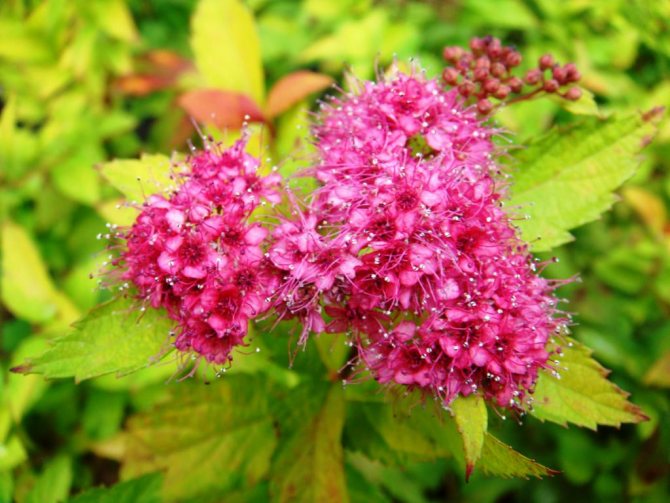

Also, the fungus can develop on the leaves, but in this case, fungicides will help to cope with the scourge - a special group of drugs that treats bacteriosis and destroys infections. Professional gardeners speak very flatteringly about a product called Fundazol, which has a wide spectrum of action. It will be enough to treat the plant with a solution and remove those leaves that cannot be saved.
However, it is not for nothing that doctors say that the best treatment is prevention. The same applies to those diseases that develop on plants. If you do not want your culture to be hit by this or that attack, just follow the optimal growing conditions. To prevent the accumulation of water in the soil, it is necessary to use a drainage layer during planting and constantly loosen the soil. And pruning branches will prevent excess moisture from stagnating in the air.
Spirea: a description of the pruning process
Spirea is a shrub with a rich crown, which tends to grow, therefore, needs such an element of care as pruning. In early-flowering varieties, only the tips that are frozen in winter need to be cut off, because they bloom along the length of the entire shoot. Once every 7-14 years old shoots must be removed completely, cutting the plant almost to the stump. From the strongest young shoots in the amount of 5-6 pieces, form a renewed bush in the future, removing the remaining branches during the growing season. After 1-2 years, pruning of the spirea will be required again, in which the bush should be rid of weak and old shoots.
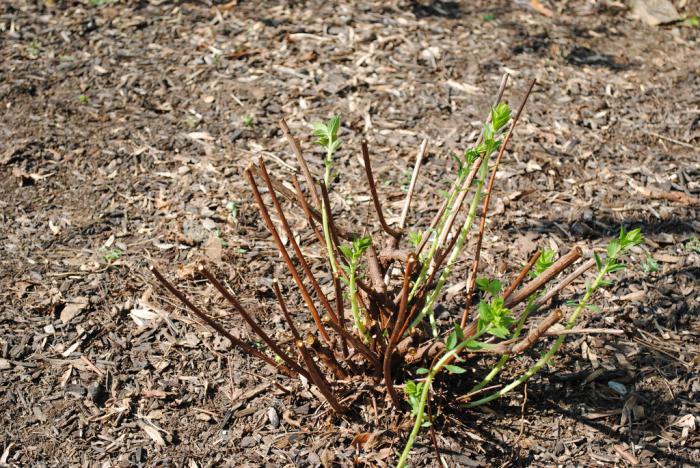

Summer flowering shrubs are pruned in early spring every year. The shoot is shortened to large buds; weak and old branches should be disposed of. The stronger the spirea pruning, the more massive and powerful the shoots will be. When the bush reaches 4 years of age, it can be cut to a height of 30 cm from the ground.
Features of growing in the suburbs
In the spring, varieties are planted that bloom in the summer, in the fall - late flowering.
Before buying, you need to inspect the seedlings. The branches should be flexible with fresh buds. Before planting, the seedling must be placed in water so that the root system is not overdried.
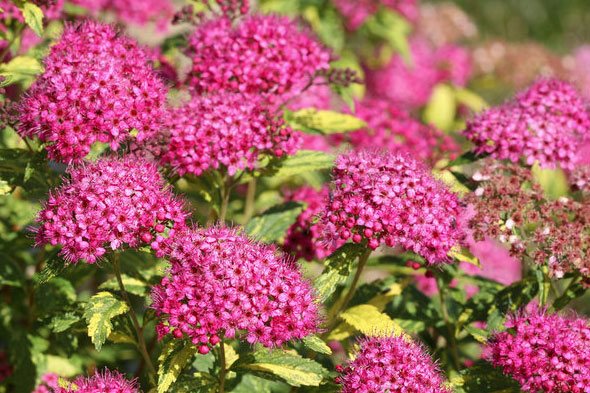

Abundant flowering in spirea is possible only in a well-lit area. Bushes need a spacious place, as the root system grows rapidly.
The size of the depth of the planting hole should exceed the length of the plant roots by one third.
It is better to plant seedlings on a cloudy day.
The drainage layer is made 15 cm. Leafy nutrient soil, a little peat and sand (2: 1: 1) are added to the hole. The mixture is mixed with the ground, the spirea seedlings are placed in a hole, sprinkled with soil, compacted and watered abundantly. The gap between plants is 50 cm, between rows 30-40 cm.
In hedges, the distance is 70-100 cm, in group compositions 1-1.5 meters.
Preparation of seedlings
The open root system of the seedlings must be put in order before planting. Overgrown roots are shortened with a garden pruner. Damaged areas are removed in the same way. Branches also require correction, especially with overdried roots. The aerial part of Japanese spirea is shortened by one third.
Before planting, seedlings with a closed root system are removed from the container and watered abundantly with water. A too dry clod of earth should be kept in water for some time before planting.


Beautiful contrast of irises and lemon-yellow leaves of Golden Carpet spirea
Growing spirea from seeds
This method of growing and reproducing spirea is not particularly popular among amateurs. It is used mainly by professionals in nurseries. Amateur gardeners use simpler breeding methods. But at the same time, there are cases when it is necessary to use this method of reproduction of spirea.
It is not particularly difficult.The similarity of seeds of an ordinary, non-hybrid spirea is quite high, up to 80%.
Sowing seeds is carried out in the spring. Basically, it practically does not differ from growing seedlings. But it will take a long time to wait for the appearance of the first shoots, 2 - 3 months. After the appearance of a couple of true leaves, the seedlings dive and grow in separate containers until the beginning of autumn. It is also practiced planting seedlings directly into open ground in a seedling bed. For the winter, young bushes take cover, and with the onset of spring they are planted in a permanent place. Spirea grown from seeds blooms in 3 - 4 years.
Preparing spirea for winter
Spirea is a frost-resistant plant. An adult plant tolerates even severe frosts. But if the winter is expected to be harsh and little snow, it is better to carry out preparatory measures in the fall. To do this, spud the root collar of the bush at the level of fifteen to twenty centimeters with earth, peat, sawdust. To insulate the roots, cover the ground around the spirea with dry leaves. You can also insulate, we love modern covering material.
Diseases and pests of spirea
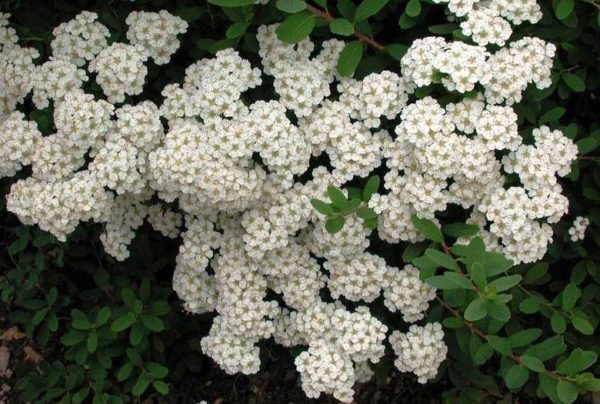

Spirea is disease resistant and pests... It is affected by aphids, rosaceous leafworm, rosaceous miner. Most dangerous for the plant spider mite... To prevent its appearance in dry summer, it is necessary to spray the plant with water every three days.
Spirea care: subtleties and care tips
The plant is unpretentious, but still loves attention to itself. She needs to provide a good sunny place, rich soil and good drainage even during the planting process, and she will delight with her flowering for many years. But many gardeners forget about some minor nuances of care, simply not seeing the need for them. But it is precisely such little tricks and approaches to spirea that will preserve abundant decoration for a long time and long seasons. It happens that the bush blooms again even in autumn, decorating the garden.
- Watering spireas need to be carried out regularly and relatively often due to the shallow root system. For a month, 2-3 times is enough or with the calculation of 1 time in 1.5 weeks. But, for example, Japanese spiraea needs more frequent watering, since it can dry out and even wither from a lack of moisture. One bush requires 2-3 buckets of water, depending on the air temperature.
- The firstcarried out in early spring, after the first pruning. For this procedure, nitrogen-containing fertilizers are used to activate the growth of young shoots. But do not forget that the first feeding should also contain potassium for immunity, phosphorus for timely and abundant flowering, and other mineral elements for normal growth. Any general purpose product or mullein, manure and droppings will do.
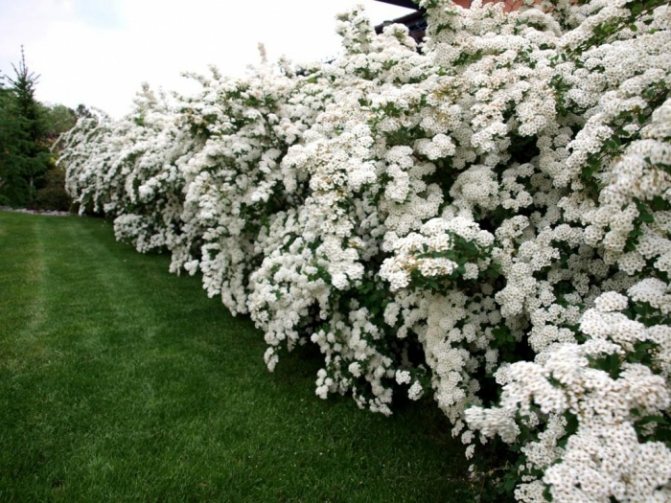

Spirea is an unpretentious plant
IMPORTANT: In no case nitrogen fertilizers are used for the winter. It is this element that is responsible for the growth of young shoots and leaves.Therefore, exclude nitrogen from the third dressing before the cold weather.
- Young bushes still require shelter for the winter. Also, some varieties or transplanted spireas are "afraid" of frost, and this procedure will not be superfluous. Use dry moss, tree leaves or grass, as well as peat and sawdust.
Spirea pruning - requires special attention. It is carried out either in early spring or late autumn. Depending on the varieties and types.
- Spring varieties are covered with buds along the entire length of the shoots, they bloom only the next year. Therefore, do not get carried away with intensive circumcision. It is enough to remove only frozen, damaged or dried sections. Circumcision is carried out once a year, at the very beginning of spring, after the cold weather has receded, when the buds have not yet ripened. But periodically you should also deal with intensive removal of old branches. This is done every 7-10 years and then the bush is cut out almost to the stump. Don't worry, spirea is gaining strength quickly.
- Do not get carried away with cutting off new young shoots! This will cause the growth of the side branches to increase. And from this the bush will lose its shape and, most importantly, the beauty and fullness of flowers, which become very weak.
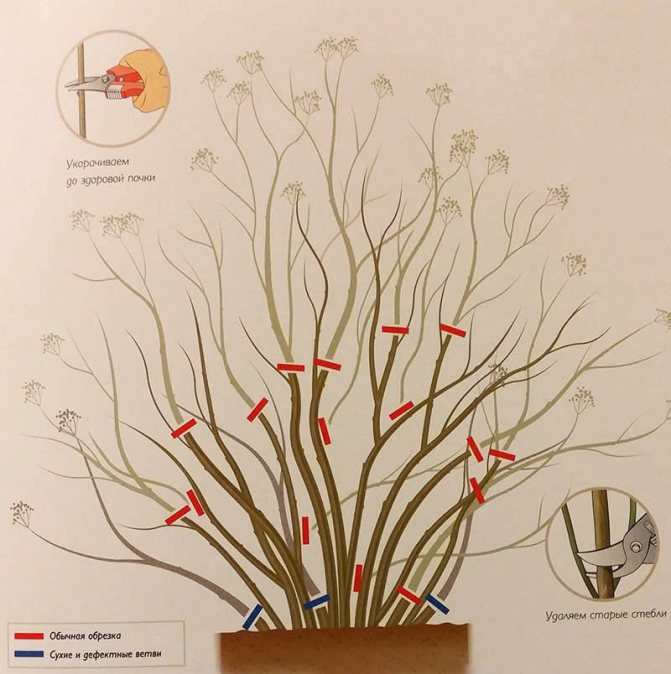

Spirea pruning
- Summer varieties characterized by the fact that at the ends of the shoots every year new inflorescences are formed, which will already dry up the next season. Therefore, circumcision is also carried out in the spring, but after the beginning of the blooming of the leaves. But circumcision is also allowed in the autumn. You need to cut each branch to the first powerful and strong bud. Young shoots should also not be left, as well as old branches, which will dry out over time. And remember - once every 4 years, almost completely the entire bush is removed, leaving only about 30 cm.
- But sometimes this procedure is not enough. Summer-flowering spireas are not distinguished by durability, therefore, they require a complete replacement of the bush every 15-20 years. You need to look at the quantity and quality of flowering.
Growing
It is not difficult to grow Japanese spirea, the main thing is to water, fertilize and carry out decorative and sanitary pruning on time. And you also need to ensure that the soil under the bushes is loose and there are no weeds that interfere with the normal growth and development of the plant. You can plant not only seedlings purchased in the nursery, but also propagate with spirea by layering and dividing the bush.
Find out when to transplant spirea.
Application in landscape design
Japanese spirea has a very effective appearance, therefore it is often used to decorate gardens, parks, alleys, alpine slides... All its varieties have very beautiful, bright colors of leaves. And when the spirea blooms, the bushes are covered with delicate inflorescences, consisting of small flowers.
It will be interesting for you to read how to propagate spirea.
These unusually beautiful bushes are planted individually and in whole groups. They form hedges for decorating parks, as well as for zoning gardens.
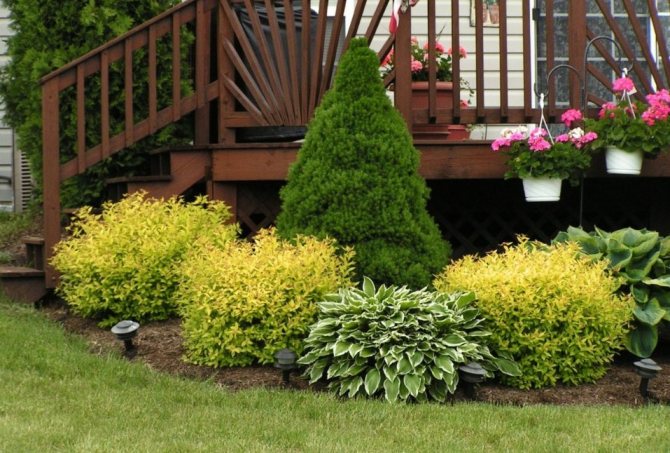

Spirea combines very well with other low shrubs and flowers, so it is used to create unusual compositions. It also looks good with many conifers such as spruce, thuja and juniper. Low-growing varieties, as a rule, are used as a ground cover, to create borders, as well as in rockeries and rock gardens.
Care
Regular and proper care of the spirea is the key to its beautiful appearance, freshness and exuberant flowering. The plant is moisture-loving, therefore it requires regular watering. The lack of the required amount of water has a detrimental effect on the growth rate of the shrub and on the quality of its flowering. In hot, dry weather, you need to moisten the culture every two weeks, using at least 10 liters of water under one plant.
Learn about the peculiarities of growing spirea of the Little Princess variety.
The mandatory procedures for caring for spirea include loosening and weeding the soil. The first event is carried out after each moistening, going deep into the soil up to 6 cm.Loosening allows you to enrich the soil with oxygen and minerals, thereby accelerating the growth of the root system. As the weeds grow, weed them. It is especially important to remove all weed plants before they begin to bloom.
Despite the fact that Jenpay is characterized by excellent frost resistance, it will not hurt to cover it for the winter with agrofibre or any breathable breathable material, after carefully bending the branches to the soil.


Common varieties
For decorative purposes about a dozen different varieties of spirea are used to decorate personal plots.
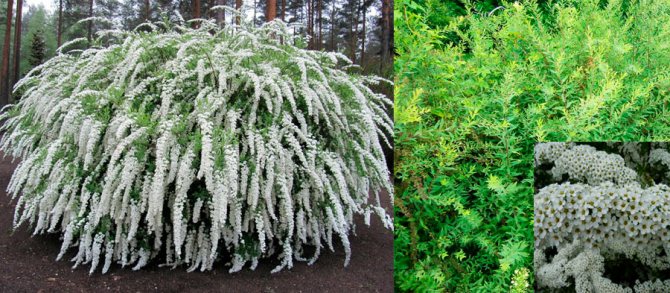

Spirea is gray. This hybrid variety has gained the greatest popularity due to its attractive appearance and unpretentious care. The shrub is large in size, reaching a height of about 180 centimeters. The inflorescences are snow-white, and the flowering is abundant. The drooping branches, during the flowering period, are all strewn with snow-white petals. This variety begins to bloom in mid-May and continues through mid-June.- Grafsheim is an ornamental, easy-to-care variety of shrubs, up to 2 meters high with long flowering. This plant is an excellent honey plant and blooms for about one and a half months. The first flowering begins already in the second year after planting the seedlings. Such a plant can be propagated by pinching and dividing the bush.
- Spirea Argut. A feature of this variety is the huge size of the bush, the diameter of which can reach 2 meters. Abundant flowering begins in June and lasts until the end of August. Numerous flowers of snow-white color, abundantly dotting the entire shrub.
- Berezolistnaya is a large-sized hybrid that is unpretentious in maintenance and can be planted to decorate a hedge.
- Spirea is average. It is a spring-flowering variety reaching a height of 2 meters. An ornamental shrub with drooping branches, which are literally dotted with small snow-white flowers during the flowering period. Flowering usually lasts three weeks and begins in late May. We note the excellent frost resistance of this variety, so the spirea planting and leaving in the Urals and Siberia will not be particularly difficult.
- Japanese spirea. A beautiful shrub with small drooping felt shoots. The height of Japanese spirea usually does not exceed 150 centimeters. It blooms for 45 days with small red-pink flowers, which are collected at the ends of the shoots. It is an extremely decorative and popular variety that is used to decorate home gardens.
- Little Princess is a dwarf species, whose height rarely exceeds 60 centimeters. The crown is rounded dark green. Flowering begins in June and lasts for a month and a half. A feature of this variety of spirea is its extremely slow growth.
- Golden princess. A distinctive feature of this type of shrub is the characteristic yellow and white color of the leaves, which is in harmony with the pink color of the inflorescences. The height of the Golden Princess can be up to one meter.
- Wangutta. A hybrid of Japanese spirits with yellow-orange leaves that change their color to copper-orange in autumn. The flowers are small red-pink, and the height of the ornamental shrub can reach 60-80 centimeters.
- The Bride variety is distinguished by its large size and long flowering period. The inflorescences are large, and the flowers themselves are snow-white. This variety is extremely unpretentious and resistant to low temperatures.
- Spirea Douglas is fast growing and reaches a height of one and a half meters. The leaves of this variety are extremely long, oblong, reaching 10 centimeters. The flowers are collected in narrow apical inflorescences and have a characteristic deep pink color. Flowering begins in July and continues through September.
- Spirea Crisp is an unpretentious variety in care, with a spherical crown with a height and a diameter of about one and a half meters.The shoots are numerous, erect, and the inflorescences are small with a diameter of 5.5 centimeters, flowers with a lilac tint of pale pink color. The flowering itself, with proper care, can last two or more months.
Where is culture used?
Spirea Shiroban is actively used for group plantings and as hedges. Dwarf varieties are great for rockeries, living carpets, rocky gardens.
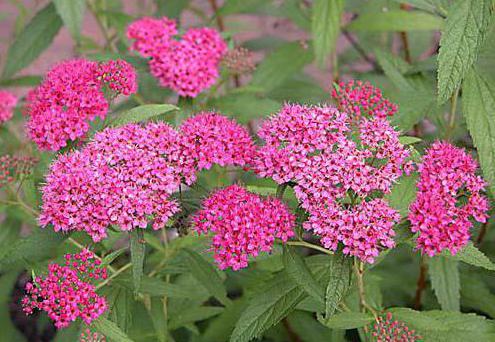

But even as a single plant, spirea looks very beautiful in areas.
There are many varieties of crops that have different flowering periods. The popularity of the plant is associated not only with the beauty of its flowers, but also with its unpretentiousness. In addition, spirea seedlings are inexpensive, which means that everyone can buy them for themselves. Having your own plant on the site, in the future you can easily grow seedlings on your own. Spirea Shiroban is good for landscape design. From plants, you can create decorative borders and whole compositions that will decorate your personal plot. Spirea is an excellent material for cutting, the plant can be given a variety of shapes. But, unfortunately, at the same time it will not bloom. In general, Shiroban's spirea is a versatile plant that can decorate a summer cottage.
Growing spirea from a cutting
This is the simplest and most common way to reproduce spirea. Moreover, all varietal characteristics of the bush are preserved with this method.
Cut the cuttings in early summer.
Annual, semi-lignified shoots are suitable for cuttings. The stalk should have about 5 - 6 leaves, from which the lower pair is removed. The rest of the leaves are shortened by half (as in the propagation of lemon). Before planting the cuttings of the spirea, it is advisable to hold for 10 - 12 hours in a solution of a root formation stimulator or dip the lower cut into root powder.
Cuttings can be planted both in a separate container with light soil, and in open ground on a specially prepared bed. It is advisable to plant the cutting with a slight slope to improve root formation. Cover the top of the handle with a transparent cap. This can be a glass jar or a wire-framed plastic bag. In the process of rooting the cuttings, keep an eye on the moisture content of the earth, not overdrying it, but not overmoistening it either. Ventilate and spray the cutting periodically. Protect from direct sunlight. For the rooting period, it is better to place the spirea stalk in a light partial shade. Protect the young plant well from frost and damage for the winter. With the onset of spring, when the spirea begins to give new shoots, transplant it to a permanent place.
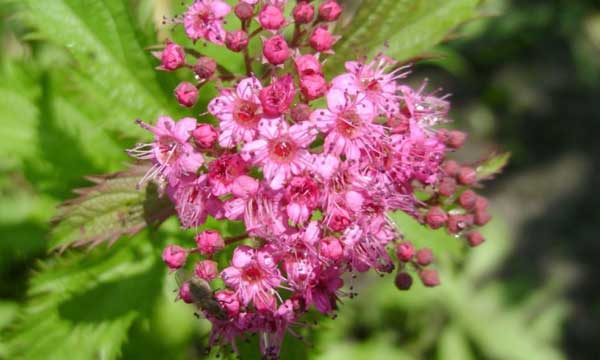

Flowering time
Depending on the characteristics of each variety of Japanese spirea, its flowering can occur in June or July. This shrub usually blooms for about 50 days. After that, the dried inflorescences can be cut off. This will help prolong flowering into fall. After pruning, the spirea will be able to delight you with its color until September, and in places with a warm climate even until October.
Did you know? Spirea shoots contain salicin glycoside, from which aspirin is made.
In what climatic zones does it grow
Due to its resistance to harsh winters and sultry summers, spirea adapts well in a wide middle lane. It can be found in almost any area of our country.
The high prevalence is also provided due to the plant's unpretentiousness to the soil composition. It can grow on various soils, this will only affect the size of the bush and its flowering.
Of course, desert Africa and the far north zone are excluded from the list of places where Shirobana can grow, but everything else is quite possible.
Origin and distribution in nature
The homeland of the shrub is the East Siberian and Far Eastern forests, some species from Europe and the black earth strip of Southeast Russia, the plant is found in the wild in North China, Japan, Mexico, grows on the spurs of mountains and open to winds in the Northern Hemisphere, along the banks of rivers and lakes form real thickets.
Cultivated throughout the temperate zone of the planet, it is highly valued in forest plantations and ornamental gardening.


Many species are excellent honey plants and sources of medicinal raw materials. The shrub is often used to strengthen the soil along the ravines.
The name of the genus Spiraea in the Rosaceae family comes from the Greek word for "bend", most likely associated with the arcuate shoots of most species.
In many botanical publications, spiraea is mistakenly called meadowsweet or meadowsweet - these are representatives of another genus Filipendula, perennial herbs, in contrast to spirea-shrubs.
External characteristics and classification of types of spirea
These shrubs belong to to the Rozova familye and have about 80-100 species. They are distributed mainly in the semi-desert, forest and forest-steppe zones of the Northern Hemisphere, and also cover the subalpine belt. The area of distribution gave the plant the ability to withstand severe frosts.
IMPORTANT: Spirea is often confused with meadowsweet. These are different plants that belong to the same family. But spirea is an ornamental shrub, but meadowsweet is a perennial herb that also lives in the Northern Hemisphere, but mainly chooses a temperate zone.
- Spirea comes from an ancient Greek word that translates as "spiral" or "bend". Which is fully justified by its branches. Often they can be creeping or curved downward, but there are species with erect branches.
- The height of the shrub starts from 15 cm and even ends with 2.5 m, depending on the variety. But they are classified into two groups: Blooming in spring spireas. Their peak of active flowering falls at the end of May and lasts until mid-June. These species do not bloom for long, but all the bushes are dotted with simultaneous and dense flowers.
- The most popular types are medium, sharp-toothed and three-lobed spirea, as well as Vangutta and Thunberg.
- Summer beauties already cover a greater period of time - from July to August. These varieties also bloom amicably on all branches. But some varieties, which are distinguished by a relatively low height and long flowering, cover almost the entire period, by gradual opening.
- The most famous varieties - Japanese, dwarf, white and willow spirea, as well as dense-flowered and Douglas.


Spirea
- The most important distinguishing and distinctive characteristic of the spirea is its flowers. They range from white, which is more typical for spring-flowering bushes, to a light or rich shade of pink or crimson color in summer representatives. But late flowering plants may even have a purple color. Flowers of all types are decorated with five petals, which are rounded. They are small, even small in size and densely adorn the branches to the very ground.
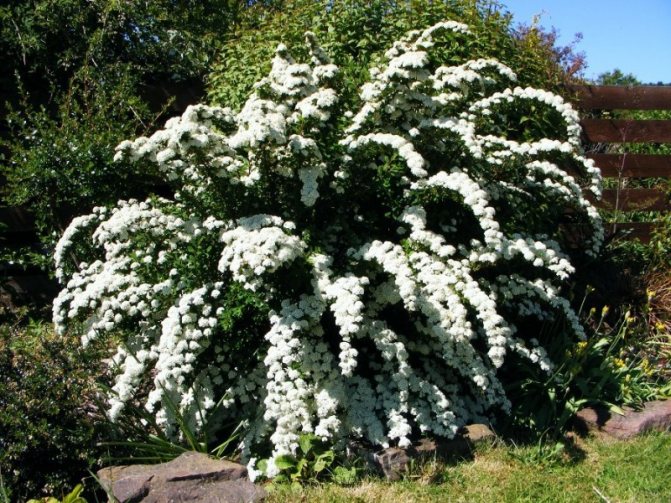

There are more species in the spirea
- The inflorescences themselves also completely depend on the species: in spring flowers these are sessile umbrellas or brushes, but the early summer representatives are decorated with bright shields. Late varieties are distinguished by panicles at the ends of long shoots.
- The leaves are also small in size and have a casting-latent shape, but sometimes round-leaved varieties can also be found.
How to plant a spirea
The spirea planting procedure is not particularly difficult. If you choose the right place and follow the care recommendations, the bush will grow well for 20-40 years.
Where is it better to plant spirea
This plant is very fond of the sun. Even in the southern regions, you need to choose an open, well-lit place for planting it.If the bush is in the shade of buildings or other trees for a long time during the day, then you should not expect a beautiful flowering from it. Only light partial shade is allowed.
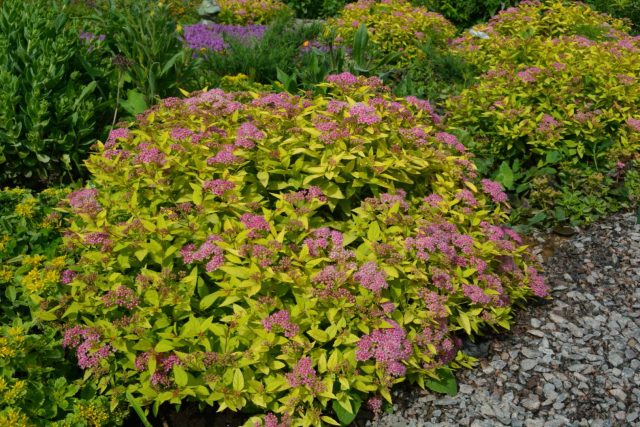

The plant does not have any special requirements for the type and composition of the soil. Light fertile soils with good air permeability are best suited for planting it. Clay areas can be improved by adding peat and sand. When planting, you should avoid wetlands, places where rain or melt water accumulates.
Preparation of planting material
This shrub can be propagated independently by seed or by vegetative methods:
- cuttings;
- layering;
- dividing the bush.
Ready-made planting material can be purchased in special stores or nurseries. Spirea seedlings are usually sold with a clay coating of the roots. You need to carefully consider them. The root system should be sufficiently developed, have several tap roots and a lobe. Spring seedlings should not have swollen buds, autumn ones - leaves. An additional plus will be if the seedling is sold in a special container.
Soil preparation
To plant seedlings, you need to dig the planting holes in advance. Their depth is approximately 0.7 m, their width is usually made 1/3 more than the size of the roots of the seedling. The pits are prepared in advance, a few days before the planned date of the work. If the soil is not quite suitable, the size of the hole should be increased.
Important! In the soil removed from the pit, you can add a little complex fertilizer, for example, superphosphate.
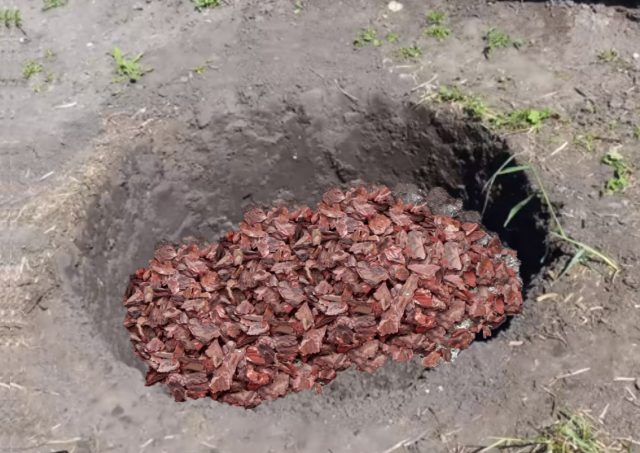

A drainage layer of broken brick or stones about 20 cm thick is laid at the bottom of the pit. A mound of soil from nutritious soil is poured into the center of the pit. In this form, the pits are left before planting.
How to properly plant a spirea
Before planting, the seedlings must be inspected. If the roots are dry, it is better to keep them in water for a while. A lobe that is too long can be trimmed. The seedling is placed vertically on an earthen mound, poured in the center of the planting pit, and the roots are spread along its slopes. After planting, the root collar should be flush with the ground, so the height of the mound of earth in the hole must be adjusted.


The hole is covered with nutritious soil, lightly tamped to prevent the formation of voids in the roots. After that, the planted bush is plentifully watered, and the root zone is mulched with peat or humus.
Distance between spirea bushes
These plants are planted both individually and in groups. If the shrub is planted as a hedge, the distance between neighboring bushes is made 0.3 m.In other cases, low-growing bushes are planted with an interval of 0.7-0.8 m, tall ones - at least 1 m.
Pruning
Japanese Jenp, due to the high intensity of shoot growth, needs annual pruning, which is carried out in two stages. The first involves the removal of dry, damaged, weak and diseased shoots. In this case, dry or damaged branches are shortened to a living bud. The procedure is carried out before the appearance of the first leaves. The second stage of the circumcision procedure involves the formation of the crown, that is, giving the shrub an aesthetically attractive, well-groomed appearance.
Important! When shaping pruning, you cannot save money, because the more branches you cut, the younger and healthier the spirea will look.
When the shrub is four years old, a rejuvenating pruning is done by completely removing all branches and leaving a 30 cm trunk. It is important to remember that each pruning action should end with feeding the bush with a solution of manure and superphosphate, mixed in proportions - 10 g of fertilizer per 10 liters of manure.
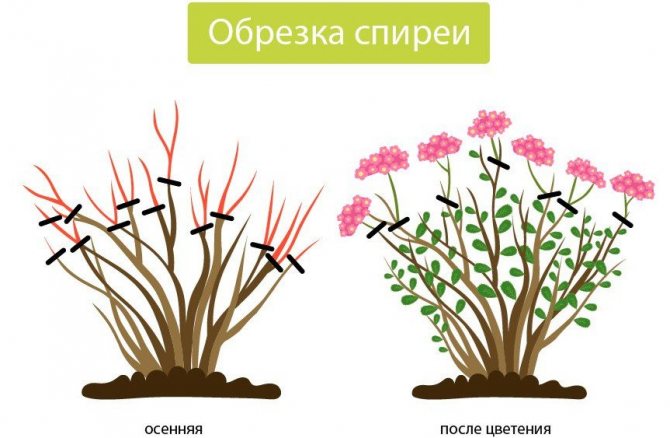

Landing
The most optimal time for planting spirea is autumn after leaf fall. Less often, the spirea is planted in early spring, immediately after the snow melts before the first buds open. The plant is not demanding on the soil, but light-requiring... Some varieties are more shade-loving, and the planting site comes from the characteristics of the variety itself.
The seedling is cut too long, unhealthy, damaged roots. The branches are shortened by an average of one third, diseased and damaged branches are cut at the root.
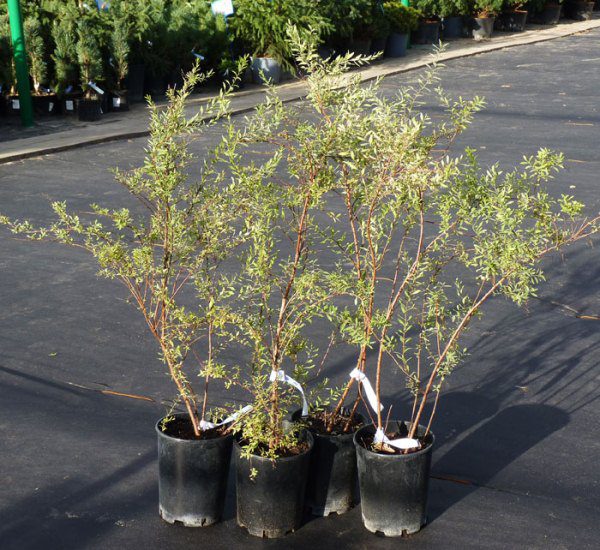

It is necessary to plant spirea in cloudy weather, ideally in the rain
If the roots have been overdried, immediately before planting, they are soaked in a bucket of water.
The planting pit should be twice the size of the root system and have strictly vertical walls. The bottom of the pit is laid with peat or turf, sheet soil. After disembarkation, the earth is slightly crushed and shed well. If the soil is clayey, a drainage layer in the form of broken bricks is added to the bottom of the pit.
The landing pit is prepared in 2-4 days.
Comments (4)
Igor
06/11/2017 at 01:50 |
Spirea shrub blooms very beautifully in our city in late May, early June. True, the flowers of the local Spirea are only white. Small inflorescences cover the entire bush and - it looks very nice.Reply
Julia Expert Plodogorod
15.01.2019 at 16:35 |
Hello Igor! Indeed, almost all varieties of spirea are distinguished by lush and abundant flowering. It can be used both as an independent landscape element and as a hedge. If you want to plant some kind of original spirea on your site, then it will not be so easy to choose, since today there are more than a hundred species of this plant. The care for most of them is the same.
For planting, it is worth choosing a sunny site, even if you live in a warm region with hot summers. If you are not planting in damp weather, be sure to make sure you wet the soil well. It should be loose and light. Abundant flowering should not be expected without the necessary fertilizers. If the soil is heavier and more viscous, then the planting hole should be made much more than the root system.
Even for group plantings, it is worth keeping the distance between the bushes at least 70 centimeters. Roots that have broken or dried up are best removed before planting. Even if you plant in rainy weather, water the newly planted spirea well.
If your variety is spring-flowering, then pruning is mainly reduced to reorganization, that is, the removal of old, dried and frozen branches. For plants that bloom in summer, the rules are somewhat different: almost all branches are shortened.
Most species, with the exception of Japanese spirea, are drought tolerant. She can die without proper care.
For abundant and long-term flowering, nitrogen, phosphorus, potassium are introduced into the ground. This is done in early spring. For those species that bloom in summer, additional feeding is needed in early summer. After the plants have faded, all flower stalks must be removed so that seeds do not begin to form. Otherwise, this process will take a lot of energy from the plant.
Reply
Ksenia
29.11.2019 at 06:38 |
Well ... it turns out that I have to transplant the spirea again ... True, I do not know how varietal it is - it was bought on occasion. But now he sits in the shadows. This is why it bloomed so badly last year.
Reply
Julia Expert Plodogorod
30.11.2019 at 01:49 |
Hello Ksenia! There are several reasons why your spirea might not bloom. To begin with, you have correctly emphasized, this plant needs a lot of light. Even if your region is southern and it is quite hot in summer, it is better to plant a bush in the sun. Light shade is acceptable, but the sun should still illuminate the crown for most of the day.
The absence of buds and, in general, a not too decorative appearance of the spirea can demonstrate if it is planted in inappropriate soil. So, for the normal development of the bush, the soil must be loose and nutritious. Good drainage, a large amount of humus or compost, and air access to the roots are important. This effect can be achieved with rippers. It can be peat, sand, old sawdust.
So that the bush does not compete with other plants for nutrients, it is better to place it a meter away from other large or medium crops.
Correct pruning is important for abundant flowering. First of all, reorganization is required. It involves the removal of frozen, dry or weak shoots. You can also check the bush for old twigs. They are removed every 2-3 years.
A common reason for the lack of a beautiful and massive flowering is incorrect or insufficient feeding. So, during the formation of buds, it is worth adding potassium and phosphorus. You can use ready-made mineral mixtures or use superphosphate and potassium sulfate. Potassium should be added at the beginning of autumn. This will increase winter hardiness and help the plant improve development and flowering in the coming season.
Before bud formation, additional watering with boric acid solution can be carried out. It is diluted at the rate of 2 grams per 10 liters of water. It is advisable to first dilute the measured dry acid in boiling water, and then pour it into a bucket or other container with water. Foliar processing can also be carried out with the described tool. This will scare off many believers.
To ensure a high plant immunity, as well as the preservation of nutrients in the soil, it is worth loosening and removing weeds.
Reply
Reproduction of spirea: methods and rules
There are four types of reproduction of such an ornamental plant. In general, special knowledge or any special skills are not required, since spirea takes root well.
Seed method
It is considered the lightest, but not acceptable in hybrid varieties. Otherwise, varietal traits may be lost. In this way, plants germinate in large numbers and do not require special conditions. Summer seeds are stored until autumn or even spring planting without special conditions.
- In the spring, you need to plant seeds in April, but in the fall - at the end of the autumn season. Low containers or even plastic cups are suitable for planting. Choose a light and loose soil, mixing it with peat. The seeds sit shallowly - no more than 1 cm into the ground.
- Seeds are treated with phytospirin or a weak solution of potassium permanganate. The last remedy pre-soak the seeds for 1-2 hours before planting. This will help prevent the onset of various diseases.
- The first shoots appear after 10-14 days. When they are 2 cm each, they dive. That is, they are seated in separate containers or in large boxes. But young seedlings are transplanted into open ground after 2-3 months.
- The place should be hidden from the scorching sun. The roots must be pinched. After planting, they must be covered with a layer of mulch. Water the seedlings often, but in moderation and regularly.
- Do not forget to loosen the soil and remove weeds in time. Bushes grown from seeds begin to bloom after 3 years.
Cuttings
- This option is the most popular, since with it the plants retain all varietal characteristics. Therefore, hybrid bushes are also subjected to this method.
- You need to cut the cuttings only when the intensive growth of the shoots ends. For spring flowering, this period falls at the beginning of June. But for summer varieties - at the end of June or beginning of July. But you can engage in cuttings in the fall, in September.
- For cuttings, shoots are chosen that grow strictly vertically. They must have at least 4 leaves, the lower ones are removed.
- Pre-cuttings are kept in water for up to 24 hours. If you want to get 100% survival rate, then you can use any rooting stimulator.
- Cuttings are inserted into containers with wet river sand, which is mixed with peat. It is not necessary to deeply deepen - 2 cm is enough. The place should be darkened and without drafts.
- They need to be constantly sprayed. For the winter period, the pots are instilled and insulated. In the spring, rooted cuttings are planted in a permanent place.


Cuttings
Growing by layering
- This method is ideal for those bushes that have many young shoots. In the spring, the lower branches are pressed to the ground and secured with forks or grooves. Their edges are cut off and covered with earth.
- In the summer, it is important to make sure that this place is well moisturized. For the winter it is carefully wrapped up, and next spring you can already plant it.
Division of the root system of the bush
- This method is only suitable for 3-4 year old plants. Young bushes are still too weak, but old spireas already have a powerful root. But, on the other hand, this method allows separation at any time of the year, except for winter. The most favorable period is September.
- The bush is dug up and soaked in water for 1 hour. It can be divided into 2 or 3 parts with secateurs. The main thing is that each ladle has several strong shoots and a strong root lobe.
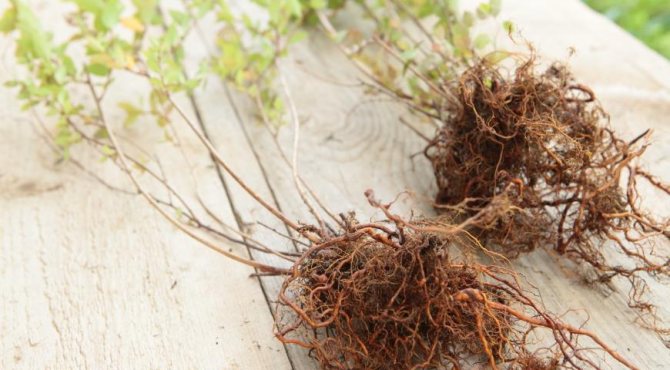

We propagate spirea
IMPORTANT: In order for the roots to take root better and grow faster after planting, they are pre-pruned.
- Divided bushes are planted in prepared holes and covered with earth. It will not hurt at this stage to fertilize the bushes. And the most important requirement for the first time is regular watering, which directly depends on the amount of rain.
Natural varieties
There are species found in nature that differ in their appearance and properties.
Among them, the most famous are the following types of spirea:
- Gray, which is popularly called the bride, thanks to the very lush bushes with long branches, almost completely covered with small white flowers. They look unusually beautiful, especially against the background of emerald foliage with a grayish tint.
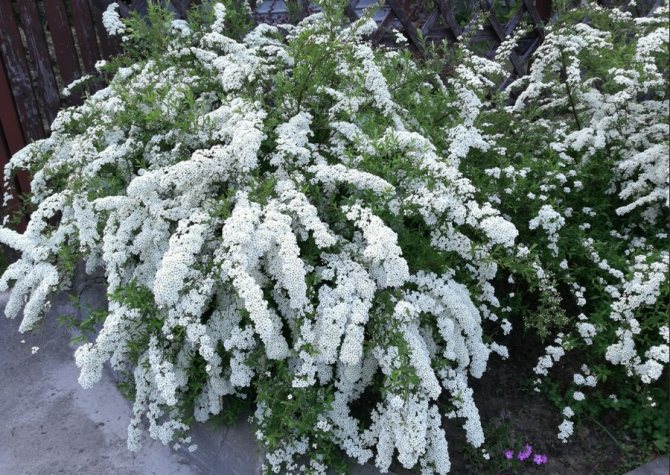

- Willowgrowing up to 2 m in height. Unlike gray spirea with weeping branches, willow spire has erect shoots on which sharp-pointed bright green leaves about 10 cm long are located.At the tops of the shoots, white or pink panicle inflorescences bloom, up to 20 cm long.
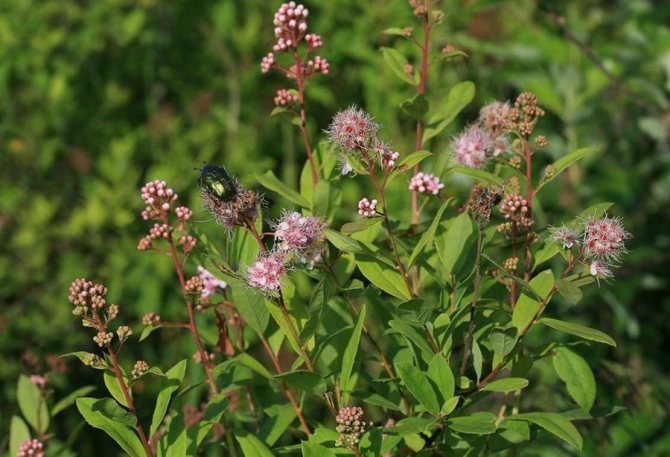

- Nippon, which also grows up to about 2 m. Its crown has the shape of a ball, moreover, it is very dense. Shoots on the bushes grow horizontally. The foliage is emerald in color, which does not change even in autumn. Small flowers are yellow with a greenish tinge.


- Paniculata, which has long erect shoots up to 1.5 m long. Its foliage is emerald in color, and its flowers are pink, collected in panicles at the tops of the shoots.
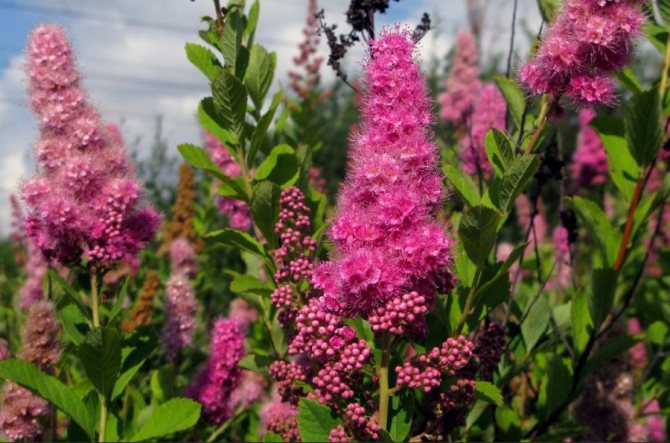

- Arguta - the earliest flowering of all known species. The shape of the bush resembles a gray spirea; it has the same inclined shoots with snow-white small flowers.
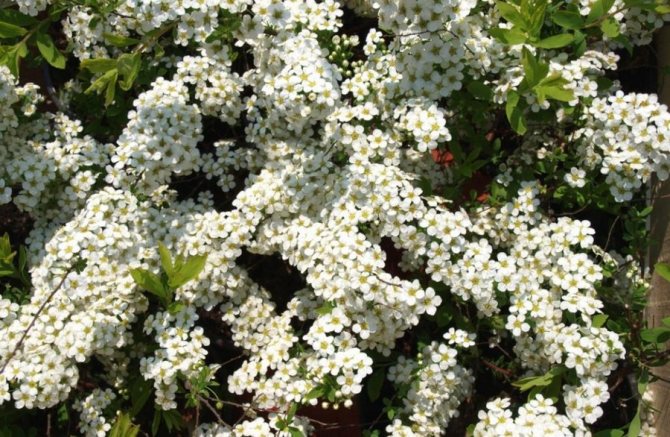

Reviews of Shiroban's spire
Kochetkova Valentina Petrovna, 50 years old, Dankov
Pros of the variety: unpretentious, very beautiful, tolerates severe frosts well. Disadvantages: did not notice. I bought Shiroban's spirea 4 years ago, I'm very happy. I don't really like messing around with flowers, but I wanted to decorate the site, so the variety is just for people like me, lazy ones. The bush grows quickly, blooms well, almost all summer. Spirea hibernates with me without shelter, I grow it in a small shade. For all the time, the bushes have never got sick, although I do not even process them. I don’t bother with top dressing either. Is that, in the planting hole poured fertilizer, and that's it. So, all care comes down to watering. In the spring, I sometimes remove dry branches. Once every 1-2 years, I cut out old branches. The bushes are neat, beautiful. In general, I recommend it to everyone.
Belousova Natalia Alexandrovna, 45 years old, Moscow.
In general, I never considered myself an avid gardener, but somehow I saw a photo of a spirea long ago, found out that it was a Shiroban variety and climbed to read the description. Fortunately for me, it turned out that caring for the bush is very simple, which is important for me - I don't want to spend a lot of time on the garden, I just want to relax at the dacha in a beautiful environment. What can I say, so far everything suits me. I planted a spirea next to the thuja, it turned out to be a good composition. Already 5 years have passed, there were no problems with diseases.Once the aphid gnawed at the leaves, but after treatment with soapy water it was possible to get rid of it. Spirea Shiroban blooms very beautifully and for a long time, all summer. The plantings hibernate well, I covered the seedlings only in the first year. Then snow copes well with insulation. I hardly even water spirea, there is enough rain in our area. Unpretentious, hardy shrub. I do pruning to a minimum, just to give the bush a beautiful look.

